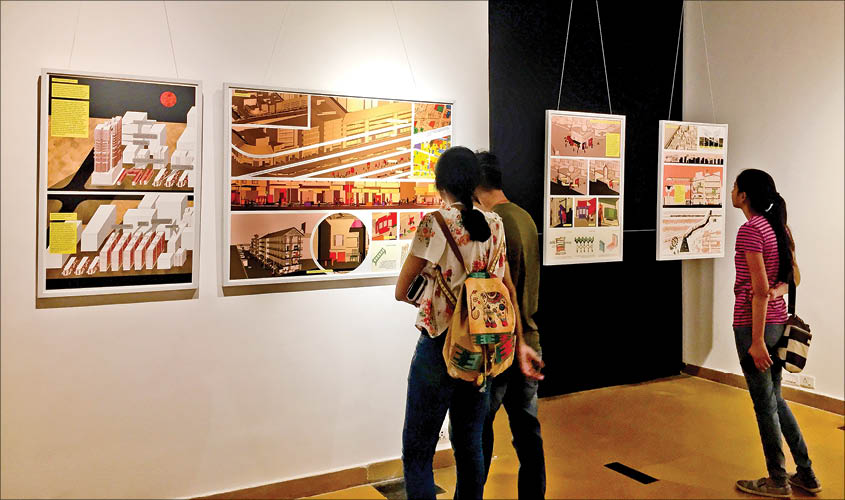Death of Architecture, the exhibition currently on view at Delhi’s India Habitat Centre, features illustrations and pictorial panels, created by professional architects, exploring the role architecture has played in the evolution of Indian cities, writes Bhumika Popli.
‘At present, the concept of meaningful architecture is coming to an end. The houses we build now are actually boxes and residents are asked to fit themselves in a box. It’s like a do-it-yourself kit with a few parts which are put together. That’s not architecture. Architecture is about how you feel in a space,” Suparna Bhalla, principal architect, Abaxial, Delhi, tells Guardian 20.
She is part of the ongoing exhibition at Delhi’s India Habitat Centre, entitled Death of Architecture. This travelling show—whose previous editions have been hosted in Mumbai, Baroda, Hyderabad and Pune—features artworks created by designers representing 13 architectural firms from across India. Through this show, the organisers aim to initiate a dialogue on the present state of architecture in the country.
Exhibited here is an artwork named in Re-memb-rane, by Abaxial Architects, which is a pictorial illustration of Delhi localities, such as Connaught Place and Nehru Place. Alongside this piece, there’s a small write-up—a personal account of the changing landscape of Nehru Place between 1985 and 2000—by architect Pradeep Sachdeva. “Nehru Place is a linear set of buildings set on an island. Being an architect, it was exciting to see buildings like Devika Towers or the Eros Hotel commence construction. Large cranes would dominate the skyline of this otherwise low lying area. But the end was a disappointing carcass of modernism. Very grey and very repetitive. Everything looked the same with no sense of identity.”
Visual artists have routinely explored the idea of urbanity in their repertoire, but here we see the same idea rendered artistically by professional architects themselves. These designs transport us to the past while showing us the mirror of the tasteless present. And the ideas the designs are based on, if taken seriously, can also help us create a better future for our cities.

The Story of Thiruporur, by Edifice Design Consultants, brings to our attention the old-school architecture of a small town in Tamil Nadu, called Thiruporur. Here, the life of residents revolved around temples. This exhibit, with graphics and photographs, compares the old and new architectural practices Thiruporur. The artwork establishes that due to careless planning, the town has been more or less cut off from its temples. “All it required at Thiroporur was not to have the arterial road plough through its heart,” reads the note by Pramod Balakrishnan, chief architect at Edifice.
Another highlight of the show is the series of computer-generated graphic-art panels, Fading of the City of Grains, which imagines Mumbai on the path to becoming the new Shanghai. One of the panels shows the transformation of the city of Bombay to Mumbai—from mills, chawls and ports, to high-rise buildings, malls, monorails, and so on. Another compares the two faces of the city—one of them is well-planned, while the other haphazardly built. One representation, using three colours, depicts the geography of the city. There are old structures with ample open spaces in front of the houses, juxtaposed with shapes that look like Shanghai-style skyscrapers.
This exhibit is designed by Vikas Dilwari, of Vikas Dilwari Architects in Mumbai. On the abrupt planning of Mumbai, Dilwari says, “We had some very good planning in the late 19th and early 20th centuries. The planning was so good that even the simplest of buildings became the heritage of today. The present-day, voter-friendly bylaws are completely eroding the heritage due to redevelopment.” Dilwari is of the opinion that due to this unsystematic redevelopment, and the lack of funding for repairing old buildings, the city’s heritage is under threat.
The Busride Design Studio, through its illustrations, collectively titled The End of Local, argues that there is actually very little left of the “local”—including locally-sourced material and cultural symbols—in current architectural practices.
But good architecture entails heavy expenses. Given the sky-rocketing real-estate prices in our time, wouldn’t a person prefer living in a box if that means a cheap house? Suparana Bhalla of Abaxial says, “I don’t believe that low-cost architecture is not good architecture. By low-cost we don’t mean we can get away with substandard. There are so many amazing examples of low-cost architecture ranging from
The exhibition is on view at Delhi’s India Habitat Centre till 17 July

